Antique Gold Floor Mirrors: Elegance and Functionality
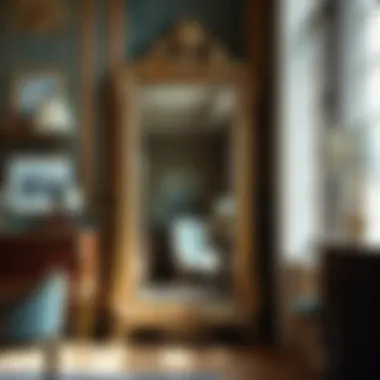
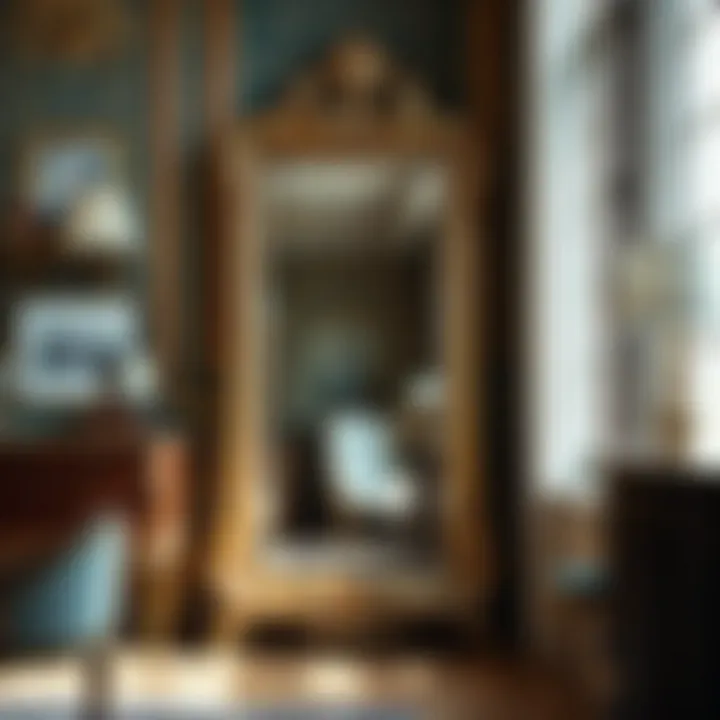
Intro
Antique gold floor mirrors have long held a unique allure, blending functionality with timeless elegance. They are not mere reflections; rather, they are portals to another era, inviting warmth and sophistication into contemporary spaces. These mirrors are chic accents that connect the modern world to history, creating narratives that enrich our homes by layering textures, hues, and historical significance.
By diving into the realm of antique gold floor mirrors, we start to see how they weave into the fabric of interior design, translating into both beauty and function. At first glance, their shimmering surfaces can take one’s breath away, yet they possess practical applications that can significantly influence how a room feels. In the following sections, we'll explore various design trends, helpful buying guides, and thoughtful maintenance tips for these captivating historical pieces.
Foreword to Antique Gold Floor Mirrors
Antique gold floor mirrors possess a unique blend of sophistication and utility, making them a prized addition to any home. These mirrors are not just reflective surfaces; they encapsulate history, artistry, and a touch of glamour that can transform a space. This introduction serves to highlight the importance of these mirrors in contemporary design, emphasizing both their aesthetic appeal and functional advantages.
One of the key elements of antique gold floor mirrors is their ability to enhance any room's light and space perception. When placed strategically, they can give the illusion of a larger area, making cramped quarters feel more expansive. This quality is particularly beneficial in urban residences where space is often at a premium. Furthermore, the warm glint of gold against the glass can add a layer of richness that enhances the overall decor.
In addition to their spatial benefits, these mirrors often act as focal points within a room. An intricately designed frame can serve as a conversation starter, drawing attention and admiration from guests. It's as if the mirror itself invites viewers to reflect on not only their appearance but also on the story woven into its design.
Moreover, antique gold mirrors offer versatile functions. They can be used in various spaces around the home—from the living room, where they can amplify style and elegance, to a bedroom, where they facilitate morning preparations. They also serve well in dressing areas and entryways, providing both decoration and practicality.
In terms of considerations, selecting the right antique gold floor mirror involves understanding the space it will occupy, aligning it with existing decor styles, and staying within budget without compromising on quality. This comprehensive approach ensures that the selected mirror not only fits well but also resonates with the homeowner’s aesthetic sensibilities.
In summary, antique gold floor mirrors stand as a testament to the convergence of elegance and functionality. They are timeless pieces that offer both practical uses and artistic charm, enriching spaces in which they reside. By choosing the right mirror, one can enhance the overall ambiance of their home with a nod to historical craftsmanship.
Historical Context
Understanding the historical context of antique gold floor mirrors is crucial for grasping their significance in today's design narratives. These mirrors are more than mere reflections; they embody centuries of craftsmanship, cultural evolution, and aesthetic principles that have shaped their use in home decor.
The Origins of Floor Mirrors
The inception of floor mirrors dates back to the late Renaissance period, a time when artistry flourished across Europe. Initially, mirrors were crafted from polished metals or glass, which were rare and incredibly valuable. The floor mirror concept emerged as a practical yet luxurious item in homes of the elite, primarily in Italy and France. These large reflective surfaces allowed individuals to view their full attire, which was particularly important during the era's emphasis on fashion.
As society progressed, floor mirrors began to reach broader audiences. By the 18th century, the production became more refined, and they started to display ornate designs, often highlighted by gilded frames. The ability to create such intricate designs stemmed from advancements in technology and artistry, making these mirrors less of a luxury and more commonplace in upper-middle-class homes.
Evolution of Gold Finishes
Gold finishes on mirrors have seen notable evolution alongside the changing tastes in design and technology. Initially, the gold was applied using a gilding technique that involved hand-dusting real gold onto the surface of the frame, lending a rich and sumptuous appearance. This method not only showcased the skill of the artisan but also fortified the value of the mirror as a decorative piece.
Throughout the 19th century, with the rise of industrialization, the gold finishes began to incorporate less expensive materials while still aiming for a luxurious look. For instance, faux gold coatings became popular, allowing broader access to these elegant designs. However, the charm of true gold still captivates a particular demographic even today, leading to a resurgence in traditional crafting techniques.
Cultural Implications of Mirrors
Reflecting not just physical images, mirrors have cultural resonance that goes far beyond their surface. In many cultures, mirrors symbolize self-reflection and introspection, playing a role in spiritual and philosophical discourse. For instance, many Eastern traditions view mirrors as tools for introspection and self-awareness, while in Western cultures, the phrase "to look in the mirror" often translates to self-examination in a more existential sense.
Antique gold floor mirrors intertwine these cultural narratives with their beauty. From dazzling ballrooms in Versailles to cozy parlors in New England homes, they have served as conversation starters and symbols of wealth and prestige. Their continuous presence in various cultures highlights their versatility and lasting appeal in the world of interior design.
A mirror doesn't just reflect your face; it reflects your intricacies and desires, inviting a deeper understanding of self and space.
In essence, the historical context of antique gold floor mirrors provides a layered appreciation for their presence in modern homes. They are not just forgotten relics but vibrant artifacts that narrate tales of human elegance, artistic prowess, and cultural significance.
Design Variations
The design variations of antique gold floor mirrors are essential to understand, as they bring a unique character and charm to any space. Each style can completely alter the ambiance and usability of your interior environment. By diving into these variations, homeowners, designers, and enthusiasts can appreciate how form and function intertwine in these stunning pieces.
Frame Styles and Materials
Different frame styles and materials not only define the visual appeal of a mirror but can also influence its functionality. Here’s a closer look at three significant frame styles:
Baroque
Baroque mirrors embody opulence and complexity. Originating from the 17th century, the Baroque style is characterized by intricate details and lavish decoration. The frames are often adorned with floral motifs and swirling shapes, capturing the grandeur of the time. For many, the key characteristic of Baroque mirrors is their dramatic flair, making them a popular choice in traditional and luxurious settings.
A unique feature of Baroque mirrors is their gilding, which enhances their intricate carvings, creating a play of light that draws attention. However, one must consider that their ornate nature can sometimes overwhelm simpler decors, potentially making a space feel crowded if not thoughtfully integrated.
Modern

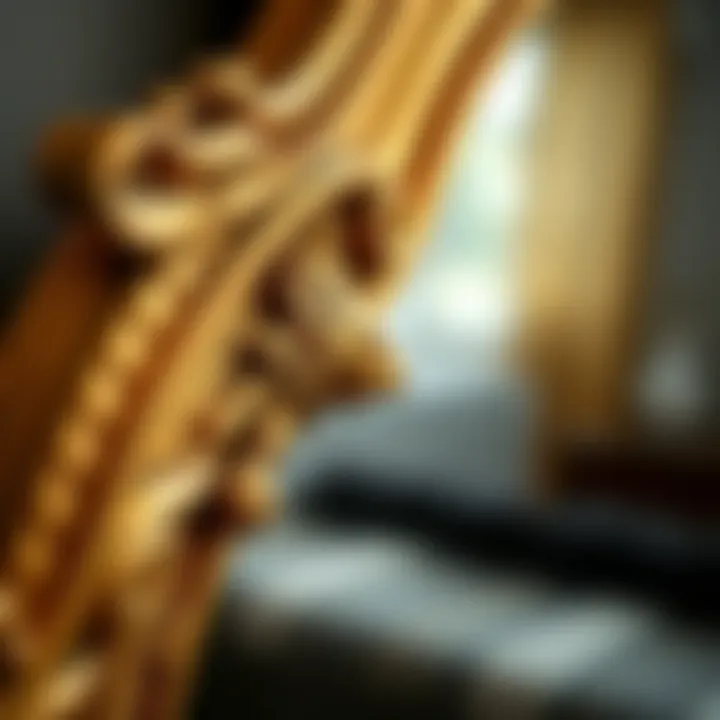
The Modern frame style provides a stark contrast to Baroque, featuring clean lines, minimalism, and functionality. The key characteristic here is simplicity, making these mirrors ideal for contemporary spaces where less is more. A beneficial choice for those with a keen eye for modern aesthetics, they blend seamlessly with various design styles without overshadowing other elements in the room.
Additionally, Modern frames often utilize materials like metal or polished wood, adding durability while maintaining their sleek appearance. However, while they might lack the grandeur of traditional styles, some may find them too plain if seeking a statement piece.
Rustic
Rustic mirrors exude a warmth and charm that can transform any space into a cozy retreat. The frames are typically made from natural or reclaimed wood, emphasizing an organic look. A prominent characteristic of this style is the intentional imperfections, which convey a lived-in feel.
Rustic frames offer significant advantages by blending well with various styles, especially farmhouse or cottage aesthetics. However, it’s essential to note that their rough edges might not appeal to everyone, particularly those who prefer a more polished look.
Size and Proportions
The size and proportions of an antique gold floor mirror can significantly influence the functionality and aesthetics of a room. Whether it’s a grand sweeping design or a compact, slender model, the right dimensions can make a big difference. For instance, an oversized mirror can create a statement and act as a focal point, while a smaller piece might fit perfectly in a cozy nook. Moreover, understanding the space where the mirror will reside allows for a harmonious balance, enhancing both comfort and style without overcrowding the area.
Reflective Surfaces
The choice of reflective surfaces can drastically affect how an antique gold floor mirror interacts with light and space. Two noteworthy options are antiqued glass and beveled edges, both delivering distinctive expressions.
Antiqued Glass
Antiqued glass reflects a sense of nostalgia, adding depth and a vintage feel to mirrors. One of the key characteristics of antiqued glass is its unique finish, which produces a soft, diffused reflection, ideal for creating a warm ambiance. This style can be a beneficial choice for those looking to enhance the historic charm of their interiors.
A unique advantage of antiqued glass is its ability to interplay with lighting, casting gentle shadows and softening bold colors. However, potential drawbacks include the fragility and maintenance required to keep it looking pristine.
Beveled Edges
Beveled edges, on the other hand, highlight a mirror's silhouette, enhancing its dimensionality. This craftsmanship lends an elegance that can elevate even the simplest design. The key characteristic of beveled edges is their ability to reflect light from various angles, creating an illusion of depth and space. This feature renders it a popular choice for those aiming to refine their space's appearance.
While beveled edges add aesthetic value, they can be more expensive due to the intricate cutting process. Nonetheless, their striking appearance often justifies the investment in design flexibility and visual appeal.
Incorporating various design elements like frame styles, size, and reflective surfaces ensures that antique gold floor mirrors not only serve their practical purposes but also contribute richly to the aesthetic narrative of a home.
Functional Benefits
Antique gold floor mirrors bring more to the table than mere aesthetics. They blend elegance with practicality, offering several functional benefits that are ideal for any space. Understanding these benefits can help homeowners and designers alike appreciate why these mirrors should occupy a place of prominence in both modern and traditional interiors.
Space Illumination
One of the standout features of antique gold floor mirrors is their capacity to enhance the illumination of a room. By reflecting light sources—whether natural sunlight streaming through a window or warm, ambient lighting from a lamp—these mirrors create a brighter atmosphere. They amplify the effect of sunlight, especially in smaller or dimly lit spaces, making them feel more open and welcoming.
Imagine placing an antique gold floor mirror across from a large window. It doesn’t just reflect what’s outside; it brings that natural glow indoors. This interplay of light can turn even the coziest nooks into inviting spots, fostering a vibrant yet serene ambiance. Furthermore, in areas like hallways or corridors that often lack sufficient light, the mirror acts as a beacon, transforming the space into a more luminous passage.
Enhancing Room Perception
Mirrors, especially those with ornate, antique frames, have a unique ability to alter how we perceive our surroundings. They can visually expand a room, giving the illusion of greater depth. This perception is particularly beneficial in smaller apartments or homes where maximizing space is essential.
When strategically placed, an antique gold floor mirror can make a room feel more expansive, thereby enhancing the overall design. For example, if you have a narrow living room, a well-positioned mirror can reflect the opposite wall, tricking the eye into believing that the room extends far beyond its actual boundaries. In this way, not only does the mirror serve a decorative purpose, but it fundamentally changes the spatial dynamics of a room, providing both function and form.
Practical Uses in Daily Living
Beyond aesthetics and spatial dynamics, antique gold floor mirrors have practical applications that make them a staple in daily life. They’re more than just a decorative addition; they serve useful purposes in various contexts.
- Getting Ready: In bedrooms or dressing areas, these mirrors are essential for checking outfits, hairstyles, and makeup. Placing one near a closet or dressing table allows individuals to assess their overall look effortlessly.
- Creating Focal Points: In entryways, they provide a functional, yet beautiful element that doubles as both a last-minute check before leaving home and an inviting focal point for guests.
- Storage Solutions: Some antique gold floor mirrors come with built-in storage or shelving. This duality of form and function maximizes utility, providing a spot to hold accessories or decorative elements while maintaining a stylish appearance.
In these various scenarios, the multifunctionality of antique gold floor mirrors showcases their inherent value, supporting the idea that decor can also enhance daily life. Their role transcends mere reflection, making them a noteworthy component in both design and functionality.
"Antique gold floor mirrors are not just reflections; they illuminate, expand, and enhance life’s little moments."
Selecting the Right Antique Gold Floor Mirror
Choosing the right antique gold floor mirror is akin to selecting a focal point in a room; it has the potential to transform your space and tie together various design elements. An antique gold floor mirror is not merely a functional item for checking one’s reflection. It's a statement piece that reflects personal style and adds depth and character to the decor. In this section, we'll delve into some crucial aspects that one should consider when making such a choice, benefitting homeowners, designers, and DIY enthusiasts alike.
Understanding Your Space

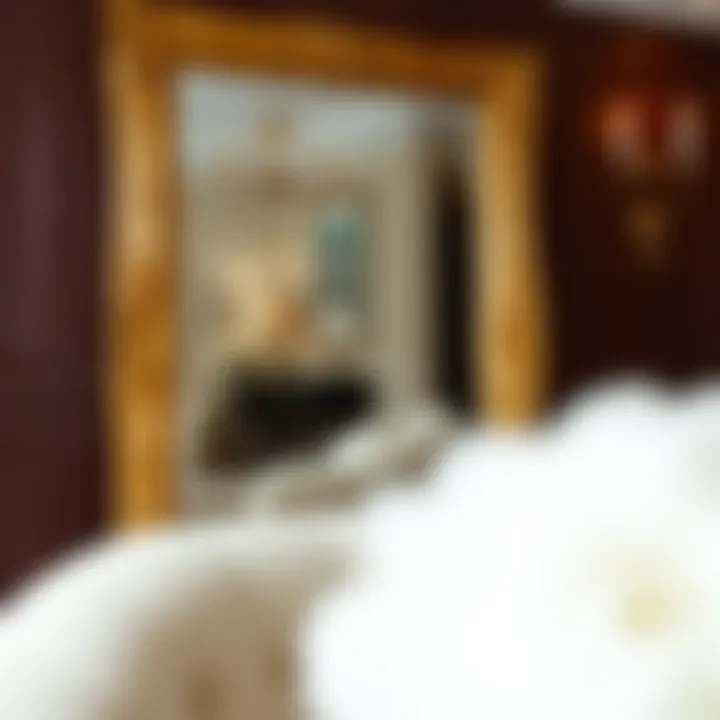
Before making a purchase, it’s paramount to consider the space where the mirror will reside. First off, measure the dimensions of the area. You don’t want a mirror that dwarfs everything else or one that gets lost in a big room. Think about the overall aesthetic of your space. Is it open and airy, or is it cozy and filled with knick-knacks? A mirror in a well-lit room can serve to reflect more light, enhancing the feeling of openness. Alternatively, in a more intimate setting, consider a more ornate mirror to complement the atmosphere.
The right mirror can amplify the light and open up the space, making even the smallest rooms feel grander.
Here are factors to consider:
- Wall Color: A wall with lots of color might demand a frame with a simple design. Conversely, a neutral wall can afford a more elaborate antique finish.
- Other Furniture: The mirror should harmonize with existing furniture. Is your decor sleek and minimalist, or are there bold, vintage pieces?
- Location: Think about where you’ll place it—near a window, opposite a light source, or in a dark corner? The position can significantly influence the mirror's functionality and grandeur.
Aligning with Your Decor Style
Once you have a grip on your space, the next step is to align the antique gold floor mirror with your overall decor style. If you lean towards the classic, you might prefer intricate Baroque designs. On the other hand, if modernity is your inclination, a minimally designed mirror with clean lines could be more appropriate.
One must also consider other styles like rustic, which may showcase more distressed finishes or use reclaimed materials. Mixing styles is also a popular choice, yet balance is key. An ornate mirror can beautifully contrast with a minimalistic Scandinavian design, adding elegance and intrigue to your space.
Ask yourself these questions:
- Does the mirror enhance or compete with existing decor?
- How does the mirror’s design reflect your personal style?
- Are there elements in the surrounding decor that you want the mirror to echo?
Budget Considerations
Lastly, while antique gold floor mirrors can come at a variety of price points, it’s important to set a budget. The beauty of antique pieces lies in their uniqueness and craftsmanship, which often means they can be pricier than their contemporary counterparts. However, there are ways to find a balance between quality and cost. Look for both new designs that mimic the antique look and genuine vintage pieces. Sometimes buying from estate sales or antique shops can yield treasures at more competitive prices.
Tips for budgeting:
- Do Your Research: Familiarize yourself with average prices for the type and style of mirror you want.
- **Consider Refurbishing: If you find an old mirror, consider refurbishing it. A fresh coat of gold paint can do wonders.
- Shop Around: Take your time—compare prices from various retailers and online marketplaces.
By taking these elements into account when selecting your antique gold floor mirror, you not only enrich your living space but also add a layer of elegance and functionality that will last through the years.
Maintenance and Care
Maintaining the beauty and functionality of antique gold floor mirrors requires attention and care. These pieces are not merely decoration; they are investments that contribute to the elegance of your home. With the right maintenance, you can preserve their allure and extend their lifespan significantly. When you treat these mirrors with respect and care, they can continue to enhance your living space for many years to come.
Cleaning Techniques
Cleaning antique gold floor mirrors is not as straightforward as it may seem. Using harsh chemicals can damage both the glass and the delicate gold finish. Instead, it is wise to use mild soap and warm water. Here’s how to do it:
- Gather your supplies: You will need a soft microfiber cloth, a bowl of warm soapy water, and a clean, dry cloth.
- Dampen the cloth: Dip the microfiber cloth into the soapy water solution. Ensure it's not soaking wet, just slightly damp.
- Wipe the glass gently: Starting from the top, wipe down the mirror using gentle circular motions. Avoid applying too much pressure.
- Dry the glass: Use the clean, dry cloth to carefully wipe away any dampness from the glass surface.
For the gold frame, it’s best to use a dry cloth to dust it regularly. If you encounter spots or grime, utilize a slightly damp cloth but avoid soaking the frame, as moisture can lead to tarnishing over time.
Repairing Damage
Over time, even the most cared-for antique gold floor mirrors may sustain little dings or scratches. Repairing these damages is crucial to maintaining not just aesthetics but also functionality. Here are some effective methods to address common issues:
- Scratches on the glass: A common remedy is to use a glass polishing compound. Apply it sparingly to a soft cloth and gently buff the scratched area in circular motions until the scratch becomes less visible.
- Frame chips or scratches: If the gold finish on the frame gets chipped, a touch-up paint in a compatible gold tone can work wonders. Apply with a fine brush, ensuring it matches the existing finish.
For more extensive damages, consulting a professional restorer is advisable. They have the tools and expertise to restore the mirror without compromising its integrity.
Preservation Tips
To keep your antique gold floor mirrors in prime condition, consider implementing these preservation tips:
- Control the environment: Keep mirrors away from direct sunlight, as this can fade and warp finishes. Humidity is another enemy; use a dehumidifier if necessary.
- Regular inspections: Frequently check for signs of wear or damage, such as loose frames or cloudiness in the glass. Early detection can make a world of difference.
- Utilize protective coatings: For gold finishes, specialized wax can create a barrier against dust and moisture. Apply it according to the product instructions, ensuring the frame remains vibrant.
"An ounce of prevention is worth a pound of cure."
By taking these steps, you will not only maintain the functionality of your antique gold floor mirror but also ensure it continues to be a dazzling centerpiece in your home, blending elegance and practicality seamlessly.
Incorporating Antique Gold Floor Mirrors in Various Spaces
When it comes to interior design, few elements have the same transformative power as an antique gold floor mirror. These mirrors are not just practical items; they can serve as focal points that provide depth, elegance, and a sense of open space. Recognizing the importance of well-placed mirrors can significantly alter the ambiance of any room. In this section, we will explore how incorporating antique gold floor mirrors in various spaces can amplify their beauty and function, creating inviting atmospheres across homes.
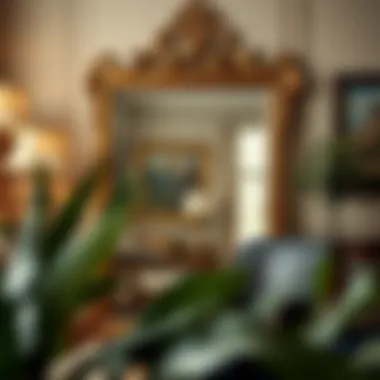

Living Rooms
In a living room, an antique gold floor mirror acts much like a window to the soul of the home. By strategically positioning one, you can reflect natural light, making the room feel larger and more inviting. Imagine an ornately framed mirror leaning against a wall adorned with soft shades of beige or pastel. The interplay of light adds warmth to the space, attracting eyes and creating a welcoming environment.
Furthermore, mirrors introduced in the right corners can also bounce light off artwork, highlighting your favorite pieces and lending depth to the room. This is good especially in smaller living areas where space might feel limited. Take care to choose a style that harmonizes with your existing decor—maybe a Baroque styled frame for a classical theme or something minimalist to fit in a modern look.
Bedrooms
In bedrooms, antique gold floor mirrors can elevate the area's glamour factor. Imagine stepping into a room that feels more expansive simply because a mirror reflects the room's light and colors. These mirrors often find their place near closets or dressing areas, creating a sense of purpose. They are invaluable in helping you decide on outfits, letting you see how items blend together without needing to move back and forth to a smaller mirror.
A tall, antique gold mirror can also serve as a piece of art—an eye-catching focal point when paired with luxurious textiles and understated furniture. The gold finish complements softer colors, making the space feel serene while retaining an element of sophistication.
Entryways
The entryway is often the first impression guests receive of your home. An antique gold floor mirror positioned here not only adds elegance but also serves a practical purpose as one last check before heading out the door. Consider placing it in a narrow hallway or near the front door to create a welcoming and polished space.
Incorporating bright, decorative elements like a well-placed rug or stylish coat rack can seamlessly blend with the reflective surface of the mirror. When guests see their reflection, it creates a sense of continuity as they step into your beautifully curated environment.
Dressing Areas
Dressing areas are the most private yet pivotal spaces in a home where mirrors reign supreme. Antique gold floor mirrors provide both function and flair in these intimate enclaves. Their elegance makes even the simplest dressing routine feel like a ritual. A full-length mirror can help you assess your outfit from top to bottom, ensuring you leave the house looking polished.
Placement is key—consider cornering the mirror to create depth, or placing it against a wall to optimize natural light. The vibrance of gold accents can also complement the hues and textures of bathroom tiles or closet features, creating a harmonious, cohesive feel.
"A well-placed mirror is more than just a reflective surface. It’s a tool to enhance beauty, space, and light, effortlessly marrying functionality with style."
Incorporating antique gold floor mirrors into your home is all about making the spaces resonate with your personal style. Whether in a living room, bedroom, entryway, or dressing area, these mirrors can serve as both elegance and functionality, enhancing the overall aesthetic and practical living experience. Taking time to choose the right placement and style ensures that this design element contributes to a thoughtful, beautifully arranged space.
Trends Influencing Antique Gold Floor Mirrors
The allure of antique gold floor mirrors transcends time, embodying both elegance and practicality. In recent years, trends surrounding these mirrors have shifted, marking a fascinating evolution in both their design and functionality. These trends significantly impact how homeowners and designers incorporate mirrors into their spaces, transforming them from mere reflective surfaces into striking focal points.
Modern Interpretations
Recent years have seen an increasing number of modern interpretations of antique gold floor mirrors. This trend emphasizes a blend of vintage aesthetics with contemporary design elements. For instance, some manufacturers have begun incorporating simplified lines and minimalist frames while maintaining the classic gold finish. This design approach appeals to those who appreciate vintage charm but are also captivated by modern simplicity.
By mixing contemporary materials, such as metal or acrylic, with traditional gold finishes, these mirrors can fit seamlessly into various decor styles. Homeowners now opt for oversized mirrors that not only serve a functional purpose but also act as statement pieces, drawing the eye and enhancing the overall ambiance of a room.
"Whether one prefers a sleek look framed in gold or intricate baroque details, modern designs allow for personal expression while honoring the past."
Sourcing Vintage Pieces
For those who cherish authenticity, sourcing vintage pieces remains a vital trend. Antique markets and estate sales frequently yield hidden treasures—pieces that carry history and character. Each scratch, dent, or patina on a vintage mirror tells a story, adding to its allure.
When hunting for these unique mirrors, consider visiting local antique fairs or exploring online marketplaces such as Etsy or eBay. Engaging with these platforms often reveals various options, from deeply ornate designs to simpler, yet equally elegant, forms. However, it is essential to verify the authenticity of the pieces, ensuring they genuinely reflect the craftsmanship of their respective eras. Incorporating vintage mirrors into modern homes can create stunning contrasts, merging different styles and timelines into a cohesive space.
Adaptation to Minimalism
As the trend towards minimalism continues to gain momentum, adaptation of antique gold floor mirrors into this style presents an interesting challenge. Minimalism often emphasizes clean lines and functional decor; however, antique gold mirrors can still be integrated effectively.
Current interpretations may involve reducing overly ornate details or selecting mirrors with a more subdued gold finish. The key lies in choosing mirrors that complement the minimalist ethos without sacrificing the charm of the antique quality. These mirrors can serve as understated accents, reflecting light and depth without overwhelming the simplicity of a chosen aesthetic. By thoughtfully placing these mirrors, one can achieve a delicate balance between historical elegance and contemporary minimalism, offering both visual appeal and functional benefits.
In summary, the trends surrounding antique gold floor mirrors showcase their versatility in modern interiors. From contemporary adaptations to sourcing authentic vintage pieces and harmonizing with minimalist styles, these mirrors continue to play an influential role in interior design, enriching spaces with their beauty and distinctive presence.
Concluding Thoughts
In wrapping up our exploration of antique gold floor mirrors, it's essential to underscore their significance not just as mere decorative elements but as artifacts steeped in history, culture, and meticulous craftsmanship. The grace that these mirrors carry is intrinsic, enhancing the ambiance of any setting in which they are placed. Their aesthetic appeal is paramount, yet it is equally important to acknowledge their functional attributes, which create a harmonious blend of form and utility.
Antique gold floor mirrors serve various purposes beyond their original roles. For homeowners seeking to brighten a dimly lit room, a strategically positioned mirror can reflect both natural and artificial light, creating an illusion of spaciousness. The reflective qualities are a boon for designers too, allowing the manipulation of visual perception in interior layouts. Designers tap into these mirrors to amplify existing decor, making a clever use of space without compromise to style.
"An antique gold floor mirror is more than a mirror; it is a portal to both elegance and practicality — a beautiful duality."
From a practical standpoint, selecting the right mirror involves thoughtful consideration of space, style, and budget. Homeowners and DIYers alike should contemplate these factors meticulously as they choose mirrors that will resonate with their home's character. Designers benefit from knowing these considerations too, ensuring their vision aligns with the buyer’s expectations and aspirations. Choosing the right mirror can transform a bland corner into a breathtaking focal point.
In the ever-evolving world of decor trends, antique gold mirrors stand their ground amid the rise of minimalism and contemporary designs. They withstand time, showing that beauty can indeed lie in the fusion of history with modern sensibilities. As more individuals appreciate vintage aesthetics paired with functionality, the demand and reverence for such mirrors continue to grow.
Moreover, as homeowners maintain these exquisite fixtures with proper care and restoration techniques as detailed earlier, their longevity and allure are guaranteed. This reflective beauty becomes an enduring companion through changing styles, proving that the old can integrate seamlessly with the new.
By melding history with modernity, these mirrors invite us to reflect on not just our own images but our personal stories, making them indispensable in the realm of interior design.















